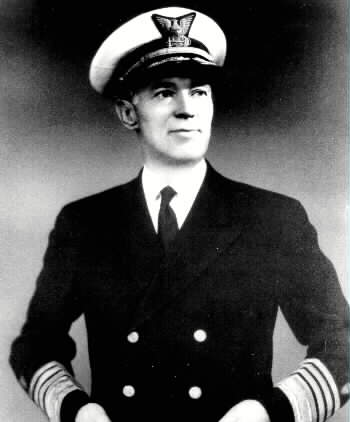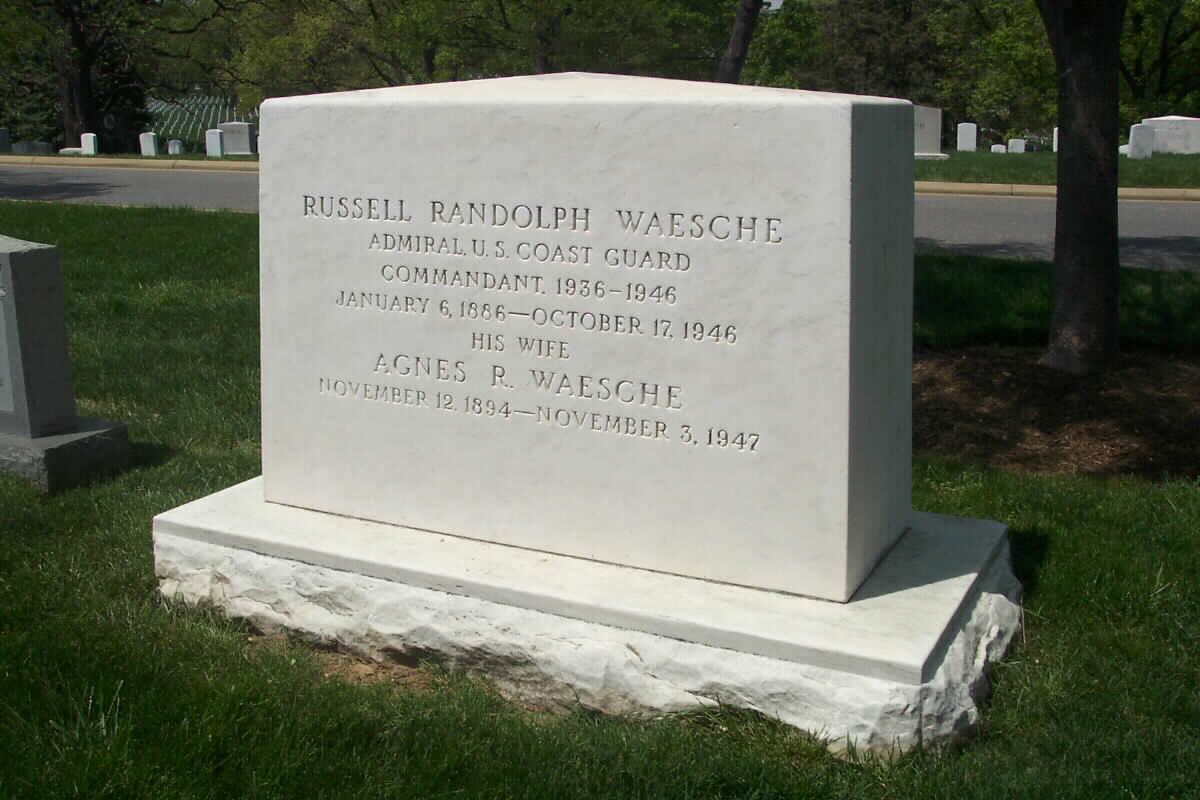Courtesy of the United States Coast Guard
Russell Randolph Waesche was born in Thurmont, MD on 6 January 1886. Having received his primary and secondary education in the Maryland public schools, he completed his freshman year at Purdue University before applying for entrance to the US Revenue Cutter Service School of Instruction. He was appointed a cadet on 19 May 1904. He graduated and was commissioned an Ensign on 27 October 1906. During his first five years in the Revenue Cutter Service, Waesche was stationed in the North Atlantic, the Great Lakes, and the Pacific Northwest. He received his first command, USRC Arcata of the Pacific Northwest Division, in October 1911. He was assigned to the cutter Pamlico in November 1912 and then began a tour at Coast Guard Headquarters in February 1915. He would remain in this position throughout the First World War.
After the war Waesche commanded the Eagle-class patrol boat Bothwell and the 152-foot cutter Snohomish. From May 1924 through March 1926 he commanded the destroyer Beale. Afterward Waesche was assigned to the Philadelphia Navy Yard and represented the USCG at the U.S. Sesquicentennial International Exposition. He later commanded the destroyer Tucker before briefly serving as the Destroyer Force gunnery officer. In March 1928 he went to Coast Guard Headquarters as Chief Ordnance Officer for the Coast Guard. Waesche also originated the Coast Guard Institute and Correspondence School for warrant officers and enlisted personnel. He developed the plan for the reorganization of Coast Guard field forces that took place in 1932. With this experience he later served in the Navy’s War Plans Division and helped develop plans to integrate the Coast Guard into the Navy in the event of war. To improve efficiency, Waesche sponsored a plan for the selection of commissioned officers. In 1935 he was made an aide to the Commandant, Admiral Harry G. Hamlet. Promoted from the rank of commander, he was appointed Commandant with the rank of Rear Admiral on 14 June 1936.
As Commandant from 1936 through 1945 Waesche insured the successful integration of the US Lighthouse Service, a purely civilian agency, with the Coast Guard in 1939 as ordered by President Franklin Roosevelt. He also presided over the greatest expansion of the USCG in its history and made sure the service maintained its separate identity while it was under the administrative control of the US Navy. Admiral Waesche saw his small peacetime fleet swell with Coast Guardsmen manning more than 750 cutters, 3,500 miscellaneous smaller craft, 290 Navy vessels, and 255 Army vessels. The Coast Guard participated in every major amphibious operation. Furthermore, activities at all Coast Guard air stations were increased as aviators engaged in anti-submarine and convoy escort operations and performed numerous search and rescue missions. In 1943 Waesche also secured Congressional support for the Coast Guard’s return to the control of the Treasury Department as quickly as possible after the end of the Second World War. In doing this, the service avoided the problems that occurred after the end of the First World War when the Navy attempted to maintain its control of the Coast Guard. Admiral Waesche earned praise from the Secretary of the Navy for his stewardship of the Coast Guard during the Second World War.
After the longest tenure as Commandant, Admiral Waesche retired from the Coast Guard effective 1 January 1946. He died shortly thereafter on 17 October 1946 and was buried at Arlington National Cemetery on 21 October. Though largely responsible for the efficient expansion of the service, Admiral Waesche also improved the traditional functions of the Coast Guard. The activities on the Great Lakes and the inland waterways were extended and intensified. His administration placed increased emphasis on maritime safety, icebreaking, and aids to navigation. As Commandant he also took a keen interest in the work in the field and frequently made personal inspections of district units and activities. In short his tenure as Commandant was one of the most successful in the service’s distinguished history.
Born on January 6, 1886, on graduating from the Coast Guard Academy in 1906, he was commissioned an Ensign and then served on the Great Lakes, the Arctic Waters and the Pacific Coast until 1920 when he was appointed U.S. Commissioner of the 3rd Division, Department of Alaska, where he was responsible for the patrol of the Bering Sea.
During Prohibition days he was sent against rum-runners; during World War II he built the Coast Guard into a force of 290 Naval ships, 255 Army vessels, 750 cutters and 3,500 various other small craft.
He served three terms as Coast Guard Commandant, 12 years. During his administration the Light House Service was transferred to the Coast Guard. During the war, he led 10,000 people providing security for U.S. ports and organized the Merchant Marine Council.
He was appointed by President Harry Truman in March 1946 to the “Elder Statesman’s Council for National Defense.” He was in 1944 elected President of the Society of American Military Engineers.
He died on October 17, 1946 and was buried in Section 8 of Arlington National Cemetery. His wife, Agnes R. Waesche (November 12, 1894-November 3, 1947), is buried with him.
Submitted By Bill Waesche
Russell Randolph Waesche, destined to be the Coast Guard’s World War II Commandant, was born in Thurmont, Maryland in 1886, graduated from the Coast Guard Academy in 1906 and spent 19 years of his first 20 years of commissioned service at sea.
Waesche was a jack-of-all-trades and master-of-many. His sea duty included the Pacific Ocean, the Bering Sea, and the Atlantic Ocean. He held commands on both oceans. During rum-running days, he commanded a destroyer operating out of New London, Connecticut. During World War I he was navigator on a Navy transport.
At Coast Guard Headquarters he served (at different times) as Chief of Communications, Chief of Finance, Chief of Operations, and in 1932 became Aide to Rear Admiral Harry Hamlet. (In those days there was only one Admiral in this small, 12,000 man service with only 665 commissioned officers.)
Waesche was modest and unassuming, but brilliant in intellect and foresight. His leadership abilities and competency in every assignment came to the attention of Secretary of the Treasury, Henry Morganthau, Jr. and in 1936 Commander Russell Waesche was promoted to be the Commandant with the two star rank of Rear Admiral, Upper Half.
The new Commandant had for years been concerned about the Coast Guard’s ability to improve safety at sea through preventive measures rather than only search and rescue. His common sense explanations and successful lobbying resulted in amalgamation with the Lighthouse Service in 1939 and the Bureau of Marine Inspection in 1943.
During World War II, Waesche supervised the expansion of the Coast Guard to 160,000 officers and men. His service manned 30 destroyer escorts, 75 frigates, dozens of attack transports, and scores of LST’s and LCI’s. The Coast Guard fought in every engagement in World War II … Atlantic, Pacific, and Mediterranean.
Commandant Waesche established the Coast Guard Auxiliary in 1939, the Reserve in 1941, and supported the transfer of the Coast Guard (as a specialized service like the Marine Corps) to the Navy for wartime service and assistance. The Coast Guard was transferred back to the Treasury Department on January 1, 1946.
Waesche was promoted to Vice Admiral (three stars) in 1943 and full Admiral (4 stars) in 1944 ….. The first Coast Guard Officer to ever achieve those ranks.
He was selected by President Roosevelt for a second four year term as Commandant in 1940 and a third four year term in 1944. He retired on January 1, 1946 due to ill health and died October 17, 1946.
ADMIRAL WAESCHE BURIED
Service Held at Arlington for Coast Guard Commandant
WASHINGTON, October 21, 1946 – A funeral service for Admiral Russell R. Waesche, Commandant of the Coast Guard from 1936 to 1945, was held today at nearby For Myer, Virginia. Burial was in Arlington National Cemetery. Admiral Waesche died Thursday in the Naval Medical Center at Bethesda, Maryland, after a long illness.
The service was conducted by Captain John Warner Moore of the Navy Chaplains Corps. Rear Admiral Raymond T. McElligott, Chief Personnel Officer of the Coast Guard, commanded the military escort.
Honorary pallbearers were Admiral Frederick J. Horne, Special Assistant to the Chief of Naval Operations; Lieutenant General Allen H. Turnage, Assistant Commandant of the Marine Corps; Admiral Joseph F. Farley, Commandant of the Coast Guard and Vice Admiral Lloyd P. Chalker, retired, former Assistant Commandant of the Coast Guard.
Also Rear Admiral Harry G. Hamlet, retired, former Coast Guard Commandant; Rear Admiral Harvey F. Johnson, retired, former Engineer in Chief of the Coast Guard; Rear Admiral Earl G. Rose, Chief Operations Officer of the Coast Guard, and Rear Admiral Paul M. Stewart, Chief Medical Officer of the Coast Guard.
Michael Robert Patterson was born in Arlington and is the son of a former officer of the US Army. So it was no wonder that sooner or later his interests drew him to American history and especially to American military history. Many of his articles can be found on renowned portals like the New York Times, Washingtonpost or Wikipedia.
Reviewed by: Michael Howard


